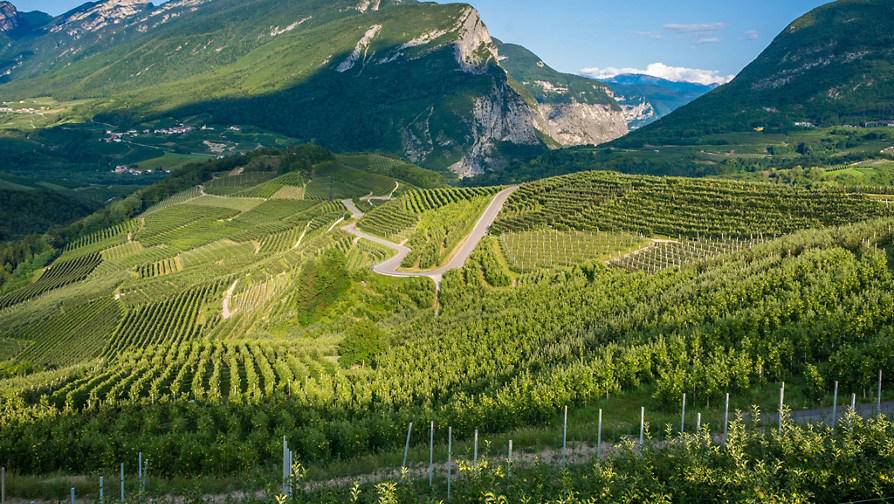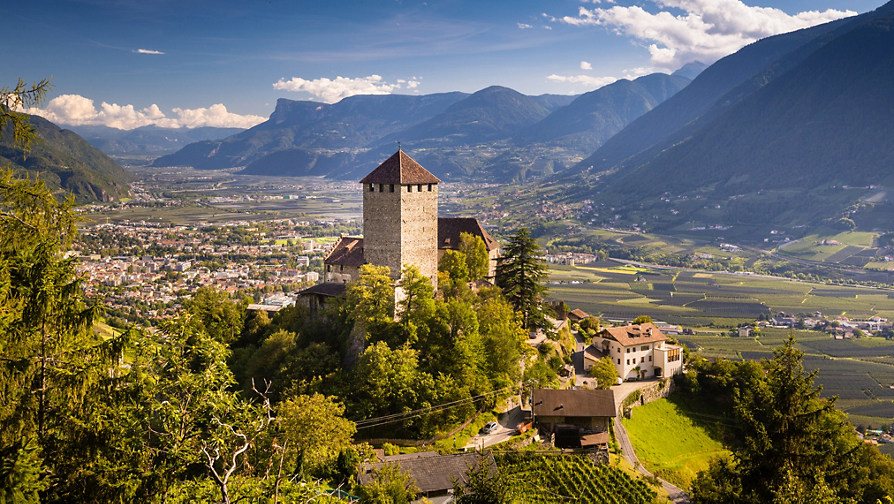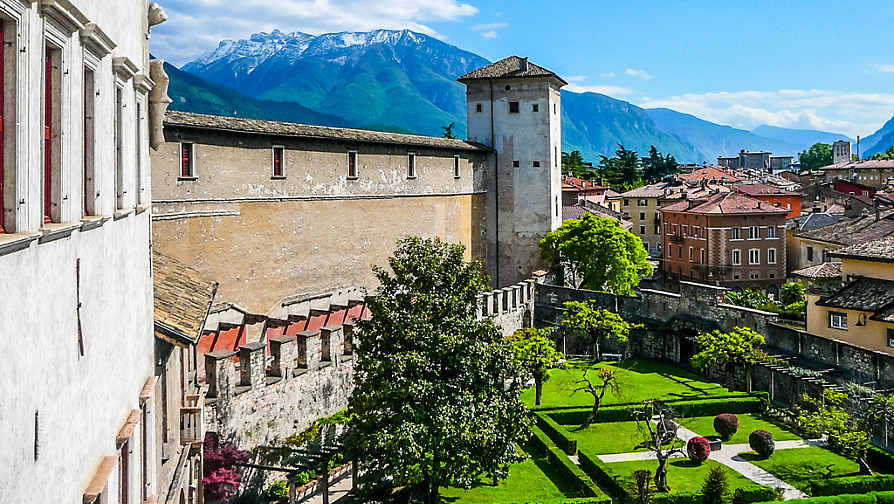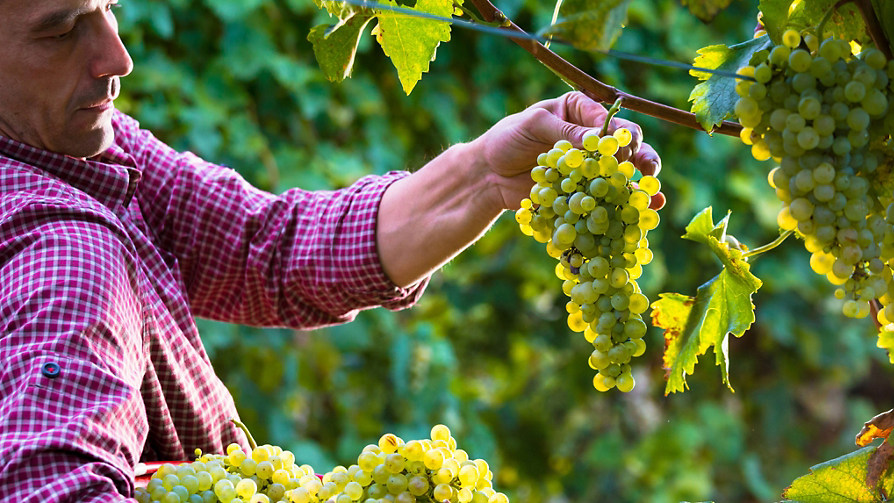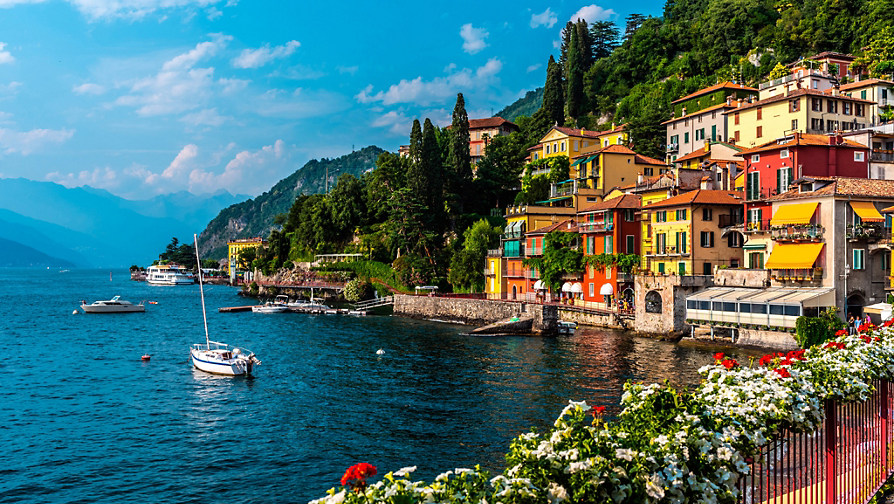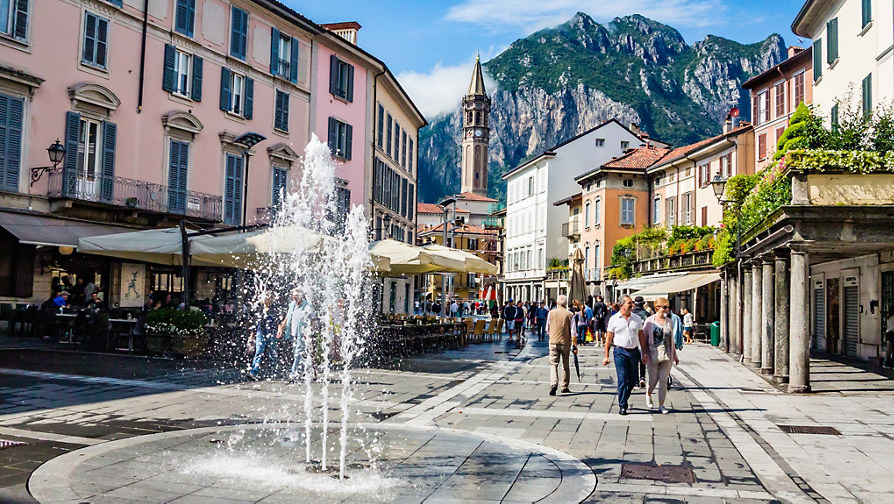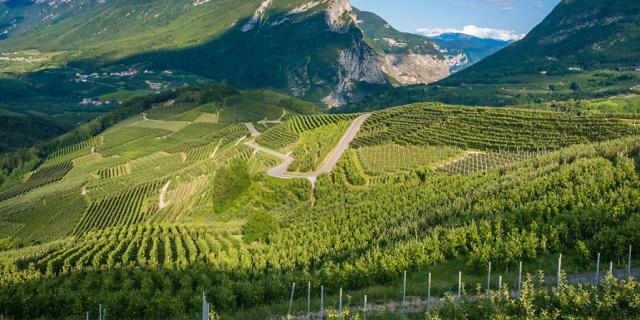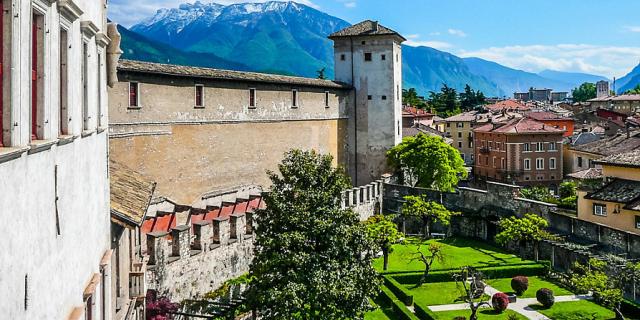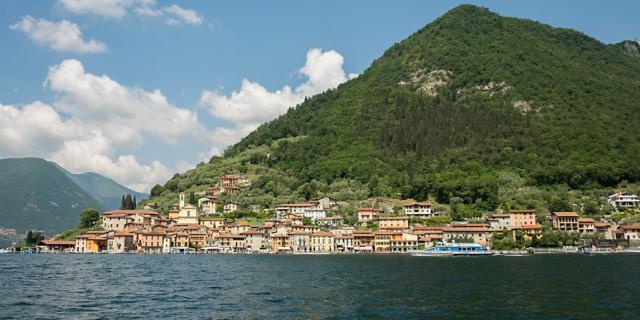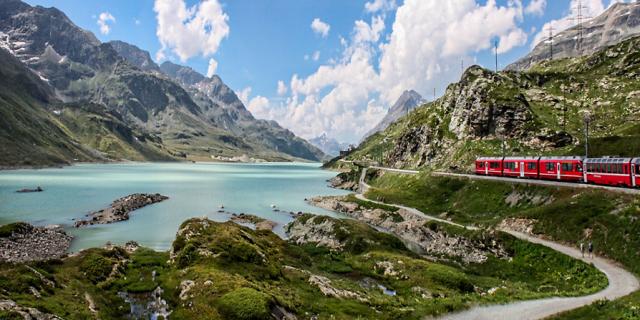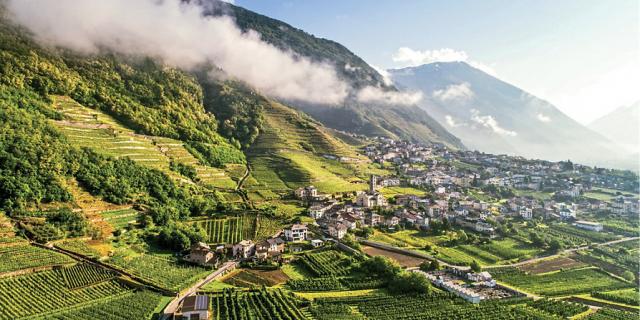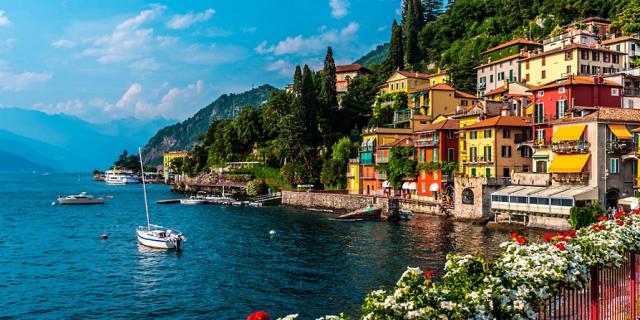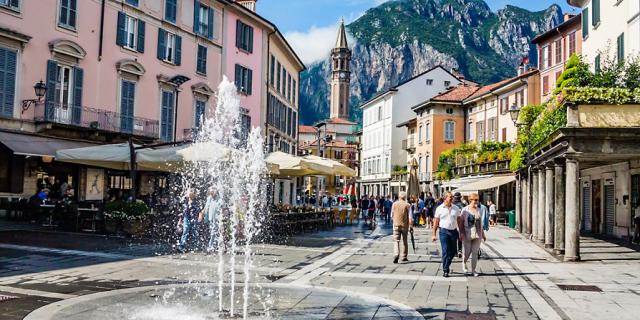- Explore in a small group of 8-16 travelers (average group size of 13)
- All land transportation
- Accommodations for 13 nights
- 28 meals—13 breakfasts, 8 lunches, and 7 dinners (including 1 Home-Hosted Dinner)
- 18 small group activities
- Services of a local O.A.T. Trip Experience Leader
- Gratuities for local guides, drivers, and luggage porters on the main trip and extensions
- 5% Frequent Traveler Credit toward your next adventure
*Airport transfers are only available for travelers arriving and departing to/from the same airport and on the same arrival/departure dates as the main trip
Please note:
Past traveler savings of 3-5% if you traveled from 2018 onward
New travelers get $100 savings
Witness the awe-inspiring landscapes and cultural treasures of Northern Italy on a journey from the fashion capital of Milan and romance of the Lombardy Lakes to the snow-covered Alps and towering pinnacles of the Dolomites. Discover a different side of Italy, and explore the enchanting juxtaposition of Italian and bordering cultures in this scenic region of woodlands, vineyards, and valleys dotted with medieval villages. Witness hidden gems and off-the-beaten path locales that are exclusive to O.A.T. And thanks to our small group size, get up close and personal with the people who live and work amidst the verdant valleys and Alpine splendor of Italy’s northernmost lands. With the insider knowledge of an expert local Trip Experience Leader, you’ll visit with local families, get to know winemakers, and meet with Ladin-speaking locals to learn about the unique language and culture they are trying to preserve in valleys hidden deep in the Dolomites.
Plus, you'll enjoy recently added features such as a visit to a local winery in Franciacorta. And you’ll ride through the majestic Alps into Switzerland aboard the legendary red train, the Bernina Express, one of the world’s most breathtaking rail journeys and a UNESCO World Heritage Site. To discover the exquisite landscapes and Renaissance splendor of what many consider Italy’s most picturesque region, be sure to join O.A.T.—because you won't find a northern Italy itinerary with all of these destinations and people-to-people cultural experiences at any other travel company.
And whenever you’d like, you have the freedom to explore more of Northern Italy on your own: Break off from the group for independent discoveries—like taking a tour of Milan's La Scala opera house or visiting a 12th-century abbey in Bressanone—during free time.
DAY 1
Depart U.S.
You depart today on your overnight flight from the U.S. to Milan, Italy.
DAY 2
Arrive Milan, Italy • Transfer to Lecco
Destination: Lecco
Accommodations: Hotel NH Lecco Pontevecchio or similar
Morning: You'll arrive in Milan sometime this morning, depending on your specific flight arrangements. Upon arrival, expect to spend about 45 minutes clearing customs and having your temperature checked. An O.A.T. representative will then meet you at the airport to escort you to your hotel. Travel in groups of 1-2 in a 4-passenger private car, or 3-4 in a 7-passenger private minivan for the 1.5-hour drive (with traffic) to our accommodations in Lecco.
In Lecco, we'll be joined by travelers who took our optional Italian Riviera, Genoa & the Cinque Terre or New! The Swiss Alps: Lucerne, Bern & Zermatt pre-trip extension.
Afternoon: Upon arrival, you will check in and receive your room assignments. We stay for two nights in the small, waterfront town of Lecco, nestled on the southeastern shore of Lake Como. Depending on which hotel we stay at, amenities may include a fitness center, bar, and restaurant. Typical rooms will include a minibar, air conditioning, Wireless Internet, and a private en suite bathroom with hairdryer.
After checking in, you’ll have some time to settle into your room and unpack, or begin getting acquainted with Lecco on your own. Your Trip Experience Leader will lead orientation walks throughout the day to accommodate the varied flight schedules.
Dinner: On your own. Your Trip Experience Leader will be happy to share their recommendations, if you’d like. The food in Lecco is heavily influenced by its geographic location and landscape. In fact, one of the most traditional dishes is risotto with perch fillets, fresh from Lake Como.
Evening: The remainder of the day is on your own—you can either rest in your room after your flight to prepare for tomorrow’s discoveries or head out to begin getting acquainted with the city. You can always ask your Trip Experience Leader for recommendations on things to do in the area.
DAY 3
Explore Milan • Controversial Topic: Immigration in Italy with Iranian political refugees Ayoub & Fazi
Destination: Lecco
Meals included: B L D
Accommodations: Hotel NH Lecco Pontevecchio or similar
Exclusive O.A.T. Activity: This afternoon, we'll gather to discuss the Controversial Topic of immigration in Italy with two political refugees. This is an extremely dire issue, as political unrest increases around the world and Italy—at the forefront due to its strategic location—is heavily impacted. Today's conversation is a unique opportunity to see this issue through the eyes of two people who had no choice but to flee their countries and seek refuge here, providing an eye-opening perspective on immigration policy. Read more about this conversation below.
Breakfast: Served at the hotel beginning at 7am, with Italian and limited American options available.
Morning: We’ll meet with our Trip Experience Leader for a Welcome Briefing around 9am in the hotel. During this briefing, we will introduce ourselves and review our itinerary in more detail (including any changes that may need to occur). Our Trip Experience Leader will also discuss logistics, safety and emergency procedures, and answer any questions we may have.
At about 9:30am, we'll head out on foot to discover Lecco. Home to just under 50,000 inhabitants, Lecco is situated about 30 miles north of Milan where Lake Como narrows to form the Adda River. It maintains a peaceful, gently winding shoreline that offers respite from the hustle and bustle of the more touristic locations in the region. Lecco features architectural landmarks such as the 19th-century medieval tower in Piazza XX Settembre, known as the Torre Viscontea, as well as the neoclassical-style Teatro della Società (Theater Society) in Piazza Garibaldi. Over the centuries, the dominant industry here has been iron and silk production; however, its involvement in such manufacturing is now mainly tertiary. During our approximately 45-minute walk, we'll have the opportunity to experience the local charms and glean both activity ideas and information about the region from our Trip Experience Leader.
Then, around 10:30am, we'll board a private 40-passenger motorcoach operating at half capacity for the 1-hour drive to Milan. Here, we'll meet with a local guide and set off on a walking tour of just over an hour through the city’s historic center. The capital of Lombardy and Italy’s second largest city, Milan, was an important trading center for more than two millennia, and once served as the capital of the western half of the Roman Empire. Today, it’s a vibrant, fashion-conscious metropolis with a population of 1.3 million. Our discoveries include a stroll through the Galleria Vittorio Emanuele II, which connects both the Teatro La Scala and the Duomo di Milano, Milan’s striking Gothic cathedral. One of the world’s largest churches (it can seat 10,000), the white-marble Duomo covers an entire city block and has some 3,200 statues and 135 spires adorning its extravagant façade—more than any other building in the world.
Around 12:45pm, we'll stop at a local café, where we'll enjoy lunch and later engage in an informative discussion.
Lunch: At 12:45pm at a local café in downtown Milan. We'll enjoy a traditional aperitif-style lunch, including regional specialties like Milanese risotto, various puff cheese pastries, and pizzette (miniature pizzas).
Afternoon: Then, around 1:30pm, we'll be joined by two political refugees to learn about the Controversial Topic of immigration in Italy, an increasingly urgent issue due to global political unrest and the strategic location of this southern European nation. In 2019, the country saw 11,471 sea arrivals to its shores—perilous journeys that are the end for many migrants—a number which continued to grow in 2020, with 16,942 arrivals by September alone. To facilitate our conversation about this dire issue, we’ll meet with asylum seekers Ayoub and Fazi.
Ayoub is a 40-year-old Iranian citizen of Kurdish origin who was forced to flee his country. The Kurds are an indigenous peoples of the Mesopotamian plains and highlands in what are now parts of Turkey, Syria, Iraq, Iran, and Armenia. They are a distinctive community, one that is often mistreated and oppressed by a number of governments, including that of Iran. While living in his home country, Ayoub actively supported the advancement of Kurdish rights, such as the ability to study in the Kurdish native language—a right that is technically guaranteed in the constitution, but forbidden in practice. As a result of his activism, Ayoub was arrested by the Islamic Revolutionary Guard and accused of orchestrating propaganda against the regime, as well as being a member of the Democratic Party of Kurdistan—an organization fighting for Kurdish autonomy. After his final brush with authorities, Ayoub knew that it was no longer safe to remain in Iran, so he made the heart-breaking decision to leave in 2011. Upon his escape, he initially sought refuge in the northern European country of Belgium, but was denied. Fortunately, Italy granted him political asylum, and he’s lived there with his partner, Eva, since 2013. Currently, Ayoub is studying for his master’s degree in New Media and hopes to graduate in 2021. On the side, he works as a freelance content creator with a fashion company, as well as a cultural and linguistic mediator.
Fazi is a 54-year old Iranian political refugee who was also forced to flee with her family when the government began persecuting followers of Christianity. In 2017, Fazi and her 23-year-old daughter and 17-year-old son began attending weekly meetings for a Christian Protestant church, where they would pray and sing with other Iranian families. However, Christian churches are forbidden to operate under the Iranian political system, so Fazi and her family were forced to attend their congregation's meetings in private. In 2019, the priest of her congregation and other members were persecuted by Iranian authorities. Fazi and her family decided to flee the country and sought refuge in Italy. After waiting through the Coronavirus pandemic, Fazi and her family were finally granted political asylum by the Italian government in 2021.
Throughout our conversation, both speakers will share with us their struggles in acclimating to a new culture as political refugees—Fazi, in particular, will provide insights into the experience as a woman, which presents a set of challenges all its own. She will also share her hopes and concerns for her children. Both Ayoub and Fazi are grateful to be granted asylum in Italy, but as we’ll find out, this status is not without its hardships and injustices.
Italy is evenly split on immigration, with just about 50% of the population in favor and 50% against it. Since the 1980s, the size of the immigrant population has doubled every decade, according to the Ministry of Internal Affairs, raising public awareness of this polarizing issue. This trend has sounded the alarm for those against immigration and ignited a far right-wing political movement, as evident by the ever-growing Lega Nord party. Lega, meaning “league,” is a prominent political platform led by Matteo Salvini that is largely founded upon its anti-immigrant stance. They believe that public resources should not be spent on non-Italians and that immigration leads to delinquency and terrorism (of which there is no proven correlation).
The other half of the country, which subscribes to the pro-immigration Democratic Party, recognizes the humanitarian aspect of this quandary. They believe that because these people were forced to flee—through no fault of their own—they should be embraced and sheltered in Italy without question. Economists also understand that migration favors the global economy, and these asylum seekers are able to fill crucial gaps in the workplace, vacancies which Italian citizens otherwise would not occupy. With the money made from these jobs, immigrants will pay taxes, thereby boosting local communities. Furthermore, cultural enrichment is a priceless advantage that fuels art, music, community, business, and more.
Our backdrop for this conversation—the region of Lombardy—is considered a relatively safe place for immigrants, due to its robust local economy. In fact, this northern region is home to more than 75% of Italy's immigrant population—the third-largest population in Europe (only trailing Germany and the United Kingdom). In May 2020 alone, nearly 10,000 people entered reception centers in Lombardy, proving the critical nature of this crisis. Italy as a whole is an ideal destination for these asylum seekers, due to its geographical location and the characteristics of its borders. However, illicit forces within Italy also make it somewhat easy to emigrate there, as it benefits the human trafficking trade. In recent years, the most frequent nationals to seek asylum are migrants from Bangladesh, Pakistan, Nigeria and Tunisia. Among these, nearly 1,000 were children and unaccompanied minors between the months of January and June 2020. Today, there are hundreds of organizations striving to assist these asylum seekers and mitigate the plight they face upon arrival, but unfortunately, the urgency of the issue far outweighs the resources.
Throughout our conversation with Ayoub and Fazi, we'll learn about this deeply divisive issue, why they were forced to flee their homeland, what it was like assimilating to Italian culture, as well as their own policy views. Both speakers will share their stories for about 15 minutes, before opening up the conversation to a 45-minute Q&A session. This is a good opportunity to ask any questions you may have and learn more about this hot-button issue.
Beginning around 2:30pm, you'll then have about 2 hours to explore Milan on your own. Perhaps you'll take a stroll along the cobbled streets of the Quadrilatero della Moda, Milan’s world-renowned fashion district. Or you may wish to visit the museums at the 15th-century Castello Sforzesco to admire Michelangelo’s last Pietà.
Alternatively, you may wish to visit Libreria delle Donne or "Women's Bookshop." Founded in 1975, this feminist enterprise is an enclave for women seeking empowerment, knowledge, and community. It's more than a bookshop—it's a sisterhood born out of poetry, literature, and philosophy. Those keen on learning about this tight-knit circle may wish to converse with the women who frequent here, including the more than 40 permanent volunteers who make it all possible, to get a sense of why this establishment is so cherished. Avid readers will also enjoy perusing the more than 10,000 books on shelf.
At about 4:15pm, we'll board our private motorcoach for the 1-hour drive back to Lecco, where you'll have a little more than 45 minutes to rest and freshen up before dinner. Around 6:15pm, our group will reconvene in the lobby for a 5-minute walk to a local restaurant.
Dinner: Around 6:30pm at a local restaurant for our Welcome Dinner, featuring authentic regional fare.
Evening: You are free to return to your room to rest before your explorations tomorrow. Or, if you’d prefer, take in the tranquil shoreline with a moonlit stroll.
DAY 4
Explore Orrido di Bellano • Transfer to Tirano
Destination: Tirano
Meals included: B D
Accommodations: Hotel Centrale Tirano or similar
Activity Note: The gelateria shop in Varenna is seasonal and may not be open during some late fall and winter departures.
Breakfast: Served at the hotel beginning at 7am, with Italian and limited American options available.
Morning: Around 9am we'll check out of our hotel and depart Lecco by private motorcoach. We'll set off on a journey of about 1 hour to reach Orrido di Bellano, a waterfall and natural gorge where caves have been carved out by the water over the centuries. Nestled along the eastern shore of Lake Como, the area has been a source of inspiration for writers and poets over the years, and was named Orrido (which means “horrific”) for the howling echo noises the water makes flowing through the series of natural caves. When we arrive, we’ll have about 45 minutes for some light hiking through the canyon with our Trip Experience Leader, and the opportunity to admire this natural wonder from footbridges attached to the rocks.
Around 11am, we’ll depart Orrido and board our private motorcoach again for a 15-minute drive to Varenna, a fishing village nestled along Lake Como. We'll head right down to the waterfront area for a stroll along the Walk of Lovers, a pedestrian footpath renowned for its views of the lake, village, and surrounding mountains. This red-fenced promenade is dotted with steep alleys and quaint corners, attracting local and international couples from around the world.
Then, at around noon, we'll stop along the way to meet with the owner of a local gelateria in Varenna. Italians take their gelato seriously, and the shop's owner will spend a few minutes telling us how only fresh locally-sourced ingredients and seasonal flavors make up the best versions of Italy's favorite frozen dessert. After we learn how to spot premium gelato, we'll test our skills by trying some samples—those who still can't tell the difference may just have to keep sampling.
Lunch: On your own around 12:30pm. There are plenty of cafés and small restaurants along Varenna's promenade, and you may want to dine al fresco at one of them to enjoy views of Lake Como and the rugged mountains with your meal.
Afternoon: We’ll regroup around 1:45pm and continue by private motorcoach to Tirano, arriving shortly after 3pm. Then, we'll check in to our hotel and receive our room assignments. Depending on which hotel you stay at, typical amenities include a spa and on-site health club. Your room will likely feature wireless Internet, a satellite TV, minibar, and private bath with robe and slippers.
After we check in, you’ll have a couple of hours of free time to relax or perhaps to begin exploring the city center of Tirano on your own. Around 6pm, all of us will gather at the hotel lobby to set off on a 30-minute orientation walk with our Trip Experience Leader. After gaining familiarity with the conveniences and points of interest in the vicinity of our hotel, we'll end our walk at one of Tirano's local restaurants.
Dinner: At about 6:30pm, we’ll enjoy dinner at a local restaurant. Here, we'll get our first taste of the local Valtellina delicacies and toast to the discoveries ahead with some nice local wine.
Evening: After dinner, a 5-minute walk will have us back at our hotel around 8pm. You have the freedom to spend the rest of your evening as you wish, whether you want to retire to your room to rest before tomorrow’s discoveries or take an evening stroll around the town.
DAY 5
Experience A Day in the Life in the Valtellina Valley
Destination: Tirano
Meals included: B L
Accommodations: Hotel Centrale Tirano or similar
Exclusive O.A.T. Activity: Our activities this morning include a NEW A Day in the Life experience in the Valtellina Valley. This included feature provides an opportunity to venture into the homes and workplaces of local villagers—from an antique mill to a cozy farmhouse—where we'll immerse ourselves in daily life and better understand regional traditions and customs. Read more about this experience below.
Activity Note: Depending on departure, some groups will spend A Day in the Life on a cheese farm in Castello dell’Acqua. Activities will be comparable to those detailed below, including the opportunity to spend time with community leaders, try your hand at cheese-making, and enjoy a farm-fresh lunch with farmstead owners.
Breakfast: Served at the hotel beginning at 7am, with Italian and limited American options available.
Morning: Around 8am, we’ll board our private motorcoach and set off for a day experiencing the region’s scenic splendor during our NEW A Day in the Life in the Valtellina Valley—O.A.T. is the only travel company featuring cultural discoveries like these in the Alpine region of Italy. Set in the Alps near the Swiss border, the valley is renowned for its natural beauty, local wines, and regional cuisine. Blanketed in orchards and terraced vineyards, Valtellina boasts winemaking traditions that pre-date even the ancient Romans.
After a roughly 15-minute drive, our first stop will be at a small, locally-owned goat cheese producer, where we'll meet the director, Luciano, and his workers. We'll witness the production process in the factory, followed by a chance to observe and even feed the cattle. Our discoveries here will conclude around 9am with a tasting of this prized dairy product. Should you like, you can also pair the cheese with a complimentary wine for an added dose of rest and relaxation.
At about 9:15am, we’ll then depart for a less than 5-minute drive to San Rocco. We'll begin our explorations with a 30-minute walk through this small village of fewer than 100 residents to get to a local mill. Since the villagers are known for their generous hospitality, our Trip Experience Leader will look for opportunities to meet and speak with them, some of whom we may encounter beating buckwheat, tending their gardens, or perhaps chopping wood. Following this light hike through gently undulating fields and a chestnut forest, we'll arrive around 9:45am at one of the few remaining stone water mills used in this community—referred to as Antico Mulino Menaglio (antique mill). There, we'll meet with the local director and volunteer, Mario. We'll hear from him about his longtime passion and commitment to ancient buckwheat production and have the opportunity to ask about the cherished culinary traditions he helps usher into the future. Buckwheat has been cultivated for centuries in the remote alpine valleys, providing work and sustenance to local populations, as well as a sense of pride and heritage. After speaking with Mario, we'll then talk with a few of the mill workers and see a demonstration of how they grind the buckwheat into flour. We'll also hear about the regional dish of pizzoccheri, a type of tagliatelle or flat pasta comprised of 80% buckwheat flour and 20% wheat flour. A classic preparation of this delicacy pairs the ribbon-like pasta with Swiss chard or Savoy cabbage, cubed potatoes, and a layered mixture of Valtellina Casera cheese and ground Grana Padano or Parmigiano Reggiano cheese—all fried in garlic and butter for a rich, fragrant finish. Pizzoccheri is commonly consumed throughout the region and beyond—in fact, the European Union recognized this dish as a Protected Geographical Indication in 2016, meaning it is acknowledged as a signature, quality agricultural product of the region, and perhaps one of the reasons the ancient art of buckwheat production is fiercely protected.
Then around 10:45am, we'll walk 15 minutes back to our private motorcoach to depart for a 10-minute ride to a small, family-run farm just outside of the village of Teglio—O.A.T. is the only travel company to visit this farm, providing you with a one-of-a-kind experience. Upon arrival, we'll be welcomed by the owner, who will share with us the history of the property and lead our small group on a short walk around the grounds. Throughout our explorations, we'll view the various animal enclosures, like the chicken coop and designated area for the goats. We'll also walk through the extensive fruit and vegetable garden. While we get to know this intimate, family-run operation, we'll even have the unique opportunity to participate in daily farm chores, such as egg collection, vegetable harvesting, and feeding the animals. Activities vary depending on seasonality and availability. As you work, keep in mind that the family employs no one to help tend the farm—they carry full responsibility of running it, and as such, have a deep sense of pride for all that they produce here.
Lunch: We'll dine with our generous hosts around 1pm in the farmhouse, enjoying a traditional farmer's meal with ingredients from the local garden, including homemade pizzoccherri and dessert.
Afternoon: At about 2pm, we'll resume helping our hosts around the farm for about 30 minutes, whether cleaning up after the meal or tending to the animals. We’ll then have another 30 minutes to perhaps hike a bit through the nearby forest, hunting for mushrooms or picking chestnuts.
Then, at about 3:15pm, we'll bid farewell to the farm and drive 30 minutes via private motorcoach ride back to Tirano, arriving around 3:45pm. The remainder of the afternoon is free to explore independently or relax at the hotel. Perhaps you'll walk around the surrounding countryside, taking in the beauty of the terraced vineyards. Or, you can consult with your Trip Experience Leader for ideas.
Dinner: On your own. Perhaps you'd like to grab a table at Parravicini Restaurant & Wine Bar, offering hearty Italian cuisine in a wine-cellar setting, or consult with your Trip Experience Leader for ideas.
Evening: You are free to spend the remainder of the evening as you wish.
DAY 6
Bernina Red Train to Switzerland • Home-Hosted Dinner
Destination: Tirano
Meals included: B L D
Accommodations: Hotel Centrale Tirano or similar
Exclusive O.A.T. Activity: This afternoon we'll venture into the home of a family in Tirano, where we'll enjoy a Home-Hosted Dinner. This is a special opportunity afforded to us by our small group size and made by possible by the regional connections of our local Trip Experience Leaders. During our shared meal, you'll learn more about daily life in the Alps from these residents, and take part in the customs and culinary traditions of the region. Read more about this experience below.
Activity Note: Please bring your passport with you for today’s discoveries, as we cross the border into Switzerland. On our cable car journey today, we will reach altitudes of almost 10,000 feet. We recommend travelers stay hydrated and eat a light lunch to help adjust to the high altitude.
Breakfast: Served at the hotel beginning at 7am, with Italian and limited American options available.
Morning: We set off today for a full-day excursion across the Alps and into Switzerland. Around 8:30am, we’ll depart our hotel for a 5-minute walk with our Trip Experience Leader to the nearby Tirano train station. There, we'll meet a local guide who will accompany us as we board the local Bernina Express Train. One of the few rail journeys designated a UNESCO World Heritage Site, the Bernina Express Train is not just the world’s highest Alpine crossing (reaching an altitude of 7,400 feet), but also the steepest, with gradients up to 7%. Panoramic views from the train allow us to sit back, relax, and enjoy the unfolding Alpine scenery as we travel over bridges and viaducts, through tunnels, and past glaciers, villages, alpine meadows, and vineyards.
After crossing the border into Switzerland, we’ll disembark the train around 10:15am at the Diavolezza station for a 10-minute cable car ride that will transport us farther up the Alps. Reaching an altitude of almost 10,000 feet, we can enjoy what is considered the best vantage point for panoramic views of the snow-cloaked mountains and glaciers. We'll have a couple of hours of free time to explore and take in the natural beauty before regrouping for lunch. Your Trip Experience Leader will provide a map of the surrounding glaciers to help you get acquainted with the area.
Lunch: Around 1pm, we’ll stop at a sheltered hut high in the Alps for a light lunch with a hot local dish and side salad.
Afternoon: Shortly before 2pm, another 10-minute cable ride will bring us back down to terra firma at the train station in Diavolezza, where we'll catch the 2:15pm Bernina Express Train back to Tirano. Our return journey will take a little over an hour and will feature the same views we saw this morning—sit back and enjoy the ride. We'll arrive back in Tirano around 3:15pm, and after the 5-minute walk back to the hotel, you are free to spend the rest of the afternoon as you wish.
We'll regroup around 6pm in the lobby of our hotel for one of the highlights of our northern Italy adventure: a Home-Hosted Dinner with a local family. When we meet the families at the hotel, we'll break up into smaller groups of no more than five travelers and then take either a 10-minute walk or 10-minute car ride to one of the homes. This is a unique opportunity to learn more about life in the region—so come hungry for your home-cooked meal, and bring plenty of questions for your generous hosts.
Dinner: Around 6:15pm in the home of a local family, which may either be a house or apartment. Learn about life in the Alps from these residents, and watch as they prepare an authentic dinner. Each family has a different background—some of them may be teachers, bank tellers, or shop owners, for example. Some families may even grow a number of ingredients used in tonight's meal in their own gardens, in which case you may have the opportunity to help harvest them. Our meal this evening will consist of typical Valtellinese dishes using seasonal products, and the family will sit down with us to savor it. You can be sure there will be wine and a traditional dessert, which might be made with seasonal fruits. Locals also often mark the end of a meal with a glass of braulio, a digestif made with medicinal herbs, fruits, roots and berries.
We’re afforded this special privilege by our small group size; by dining in groups of no more than 5, we’re given the chance to enter local homes and connect on a one-to-one level, and to even share a little with our hosts about who we are and what has brought us to Italy. This will be a great opportunity to ask them about life in Tirano, any customs they practice, and more.
Evening: Around 8:15pm, we'll take either a 10-minute walk or 10-minute car ride back to our hotel. As this is our final night in Tirano, you may wish to take in the town nightlife over a glass of wine at an outdoor café, or retire early to rest up for tomorrow’s discoveries.
DAY 7
Overland to Lake Iseo • Franciacorta vineyard and winery tour
Destination: Lake Iseo
Meals included: B L D
Accommodations: Cocca Hotel Royal Thai Spa or similar
Breakfast: Served at the hotel beginning at 7am, with Italian and limited American options available.
Morning: We depart Tirano around 8:30am and journey by private motorcoach to Lake Iseo, the least known of the Lombard lakes, and the Franciacorta wine region. Our total drive time will be approximately 3 hours, but after about 45 minutes, we'll stop in Edolo. There, we'll witness sweeping views of Val Camonica, an ancient valley in the central Alps carved by glaciers and named for the Camuni people who inhabited the region in the Iron Age. We may also make a special stop at the local university here, where we'll meet with students Paola and Sara for a little more than 1 hour to learn about their various projects concerning environmental issues. These students aim to raise awareness about nature preservation in the area, and in doing so, hopefully galvanize support for their efforts from local residents and beyond.
We'll continue driving around 10:30am, arriving in Franciacorta around 11:15am. Upon arrival, we'll begin our discoveries with a short hike that will reveal why this region is able to produce some of the best sparkling wines in the world. Then, at around 12:15pm, our hike will bring us to one of the local wineries that produces the famous Franciacorta wines—a recently added feature. The winery is run by two sisters, Chiara and Maddalena. We'll be welcomed by one of the sisters and learn why it was important for them to keep the business relatively small in order to maintain high production standards. On a personal level, we'll hear about the sacrifices the sisters made, and continue to make, to keep the family business and tradition alive. Our conversation will also reveal the secrets of methode champenoise, the special method used in Franciacorta to produce the wine’s “sparkle.” This variety of wine is hand-harvested, fermented in wooden casks, and aged by law for 18 months—an intricate, centuries-old process we'll gain insights on and have the opportunity ask in-depth questions about. We'll also enjoy a tour of the wine cellar, as well as the mansion located on the grounds.
Lunch: At the winery around 12:30pm. As we sip three varieties of the wines produced here during a tasting, we'll be served a light lunch of local specialties to cleanse our palates and enhance our appreciation of the fine wines of Franciacorta.
Afternoon: Around 3pm, we’ll board our private motorcoach and drive about 15 minutes to our hotel. Depending on where we stay, our hotel will likely be situated along the shores of Lake Iseo. The grounds may feature amenities such as an outdoor swimming pool, private beach, and restaurant. Typical rooms include Wireless Internet, air conditioning, a private bath, and flat-screen televisions.
After checking in, you are free to spend the rest of the afternoon as you wish. You can relax in your room, join your Trip Experience Leader on a walk through town, or join a few of your fellow travelers for a stroll along the lake’s edge.
Dinner: Around 7:30pm, our small group will gather for our first dinner at the hotel. Our meal will feature regional Italian cuisine with an appetizer, main course with side dish, and dessert. Bottled water, soft drinks, one beer, or a glass of wine are included.
Evening: You are free to return to your room to rest before your explorations tomorrow, or join fellow travelers in the villa’s main area for a nightcap to discuss the day’s activities.
DAY 8
Lake Iseo • Montisola • Optional Brescia tour
Destination: Lake Iseo
Meals included: B
Accommodations: Cocca Hotel Royal Thai Spa or similar
Breakfast: Served at the hotel beginning at 7am, with Italian and limited American options available.
Morning: Most of today is all yours. You can relax with a book by the side of the lake, take advantage of the amenities at our lakeside hotel, or head out for some independent exploring. You might also ask your Trip Experience Leader about the possibility of taking a local ferry boat to Montisola. If you make it out to this island in the middle of Lake Iseo, you can go for a bike ride, stroll the ancient cobbled streets, or just watch the local fishermen haul in their catch using the same methods their ancestors have used for centuries.
Lunch: On your own. You can have lunch right in the hotel's restaurant or maybe check out the dining options in Pilzone, a small village about five minutes walking distance from the hotel. Whatever you're in the mood for, your Trip Experience Leader can point you in the right direction.
Afternoon: Your free time continues this afternoon, with the option to stay in Montisola, or perhaps take a hike through the Valerian trail.
If you'd like, you may join an optional tour of the town of Brescia to discover its culture. Those taking the tour will meet in the hotel lobby at 3pm and take a 1-hour drive via private motorcoach to Brescia. After arriving around 4:15pm, we'll meet our local guide and begin a walking tour of the city. We'll stop at sights such as the Piazza della Loggia, a locals-only market filled with artisans, and the Tempio Capitolino, one of the few remaining Roman ruins in the area that includes a well-preserved crypt. Around 5:00pm, we'll take an hour to explore the ruins in depth, learning how they were once buildings that played an important role in local life, such as a theater thought to have held over 15,000 people and an ancient law court.
Our tour will conclude around 6:15pm, when we will take a 10-minute walk to a local restaurant for dinner.
Dinner: On your own this evening, ask your Trip Experience Leader for recommendations. Those on the optional tour will enjoy dinner at a local restaurant around 6:30pm, featuring casoncelli, a local ravioli specialty filled with meat, butter, and bacon.
Evening: Free to retire early or gather with a few fellow travelers to work off dinner with a refreshing lakeside stroll. Those on the optional Brescia tour will return to the hotel at 9:30pm.
Brescia Optional Tour - $150/person
Upon arriving in Brescia, we'll meet our local guide and begin a walking tour of the city. We'll stop at sights such as the Piazza della Loggia, a locals-only market filled with artisans, and the Tempio Capitolino, one of the few remaining Roman ruins in the area that includes a well-preserved crypt. We'll explore the ruins in depth, learning how they were once buildings that played an important role in local life, such as a theater thought to have held over 15,000 people and an ancient law court. Once our tour concludes, we'll enjoy dinner at a local restaurant.
DAY 9
Transfer to Trento • Controversial Topic: LGBTQ rights in Italy with activist Lisa Perlini • Visit Verona
Destination: Trento
Meals included: B D
Accommodations: Grand Hotel Trento or similar
Exclusive O.A.T. Activity: Today's discoveries will include a discussion on the Controversial Topic of LGBTQ rights in Italy. In such a strongly Catholic country, LGBTQ rights are hotly contested by many Italians. We'll meet with a volunteer from Rainbow Families, an organization that advocates for and supports LGBTQ rights. Read below to learn more about this activity.
Breakfast: Served at the hotel beginning at 7am, with Italian and American options available.
Morning: Around 8:30am, we board our private motorcoach and depart our villa for the almost 3-hour drive to Trento, with a stop in Verona along the way. At about 10am, we’ll arrive in Verona, the city made famous by Shakespeare’s star-crossed lovers, Romeo and Juliet—and second only to Rome in its number of ancient Roman ruins (in fact, the Roman Empire dubbed Verona as Piccola Roma or "little Rome"). After we meet our local guide, we’ll set out on a roughly 1-hour walking tour of the city that includes a stroll through the market at Piazza delle Erbe (the old Roman forum).
At about 11:30am, we'll make our way to the longest-operating LGBTQ nightclub in town. There, we'll meet a representative of a local association to discuss the Controversial Topic of same-sex marriage and LGBTQ rights in Italy—issues that are increasingly at the forefront of cultural discussions and clashes.
This morning, we'll meet Lisa Perlini, a volunteer with Famiglie Arcobaleno, or Rainbow Families (when Lisa is unavailable, we will meet with another volunteer). Founded in 2005, the organization was developed to support and advocate for the LGBTQ community, as well as advance society's perception of LGBTQ nuclear families, ultimately demonstrating that who we love or how we identify should not limit our freedoms.
Besides her broad understanding of the topic from a legal and cultural standpoint, Lisa can speak to this issue personally. In 2013, she and her partner at the time had a son, Giovanni. A few years later, same-sex civil unions were passed into law, granting limited rights to same-sex couples, such as the ability to visit a partner in the hospital or incorporate them into your will. Following this groundbreaking legislation, Lisa and her wife married—along with 15,000 other same-sex couples since 2016. Shortly thereafter, Lisa’s wife submitted an application to the juvenile court requesting the right to adopt Giovanni. They were among the first couples to do so, and after a long and arduous court battle, Lisa and her wife are now legally acknowledged as Giovanni’s parents. Today, Lisa and her wife work closely with Rainbow Families to establish a community for families like theirs, where they can access resources, seek legal assistance, and raise awareness throughout Italy.
Lisa will begin our conversation with a brief history of the organization, outline their advocacy work, and illustrate how they continue to combat opposing forces, such as the radically conservative coalition of the World Congress of Families. Italy is one of the last countries in Western Europe to make any progress on this issue, ranking 35th out of 49 European nations regarding LGBTQ rights. Although same-sex unions may seem like a victory for the movement, the legitimacy of these legal partnerships is commonly disputed by those who aim to reverse the historical ruling. Furthermore, unlike "traditional" marriages (viewed by many Italian citizens as the union between cisgender men and women), same-sex couples do not benefit from a number of rights, such as workplace discrimination protections or equal opportunities pertaining to fostering and adoption. These are highly contentious and emotional issues among the LGBTQ community, which continue to be challenged in the court system.
Being the home of the Vatican, this divisive subject has received a great deal of attention, and consequently, backlash. Italy is overwhelmingly Catholic, with more than 80% of the population identifying as such—many of whom are staunchly against social progress in the name of their religion. However, despite the historically conservative nature of Catholic leadership, the sitting supreme pontiff, Pope Francis, has openly embraced the LGBTQ community in recent years, giving its supporters reason to believe public opinion could eventually evolve. But with this shred of hope comes much frustration. LGBTQ people are at considerable risk of being targeted in their own communities, whether at the hands of physical violence, blackmail, verbal abuse, sexual assault, or workplace discrimination—in fact, Italy saw a 33% increase in such cases as of 2019—and perhaps more disturbingly, precise punishments for these crimes are not in place. The risk of such occurences are also very real: According to Pew Research Center, roughly 20% of the population does not believe LBGTQ people should be accepted (compared to just 8% in the Netherlands and 5% in Sweden), putting this vulnerable group in a considerably treacherous position. Youth are even more susceptible, as this unacceptance often results in homelessness.
Unfortunately, Verona is the appropriate backdrop for such discussion. This beautiful, ancient city also happens to be a hotbed of far right ideology. In fact, it is the epicenter of a new order of far-right militants with ties to the current mayor, Federico Sboarina, and the current Minister of Family, Lorenzo Fontana, who openly supports the agenda of the highly conservative World Congress of Families. Furthermore, local government is largely occupied by members of Lega Nord (or Lega, meaning “league”), a right wing political party led by federal secretary, Matteo Salvini. With its presence growing in Verona, the city has continually found itself at the center of cultural clashes between ultra-religious citizens and pro-LGBTQ protesters.
Today's conversation will address a complex and emotionally charged subject here in Italy. The topic is layered with sensitive cultural elements, which may lead to conversations that some travelers find difficult. Approach the conversation as a unique and respectful discourse. After gleaning insights on this issue from Lisa for about 20 minutes, the conversation will open up to a 45-minute Q&A session, giving us the opportunity to probe deeper into this delicate issue.
Lunch: On your own in Verona around 12:30pm. There are plenty of dining options in a city known for its wild game and hearty fare like risotto and gnocchi. You could always go for a nice plate of bigoli, the signature pasta of Verona shaped like spaghetti, but much thicker. Or you could just ask your Trip Experience Leader for restaurant recommendations.
Afternoon: From about 12:30pm, you'll have 2 hours to explore Verona on your own. Perhaps you'll check out the Arena di Verona, the grand Roman amphitheater built in the first century A.D. With seating for 30,000, the Arena is still in use today and renowned for its presentations of open-air opera performances. Alternatively, you may wish to consult with your Trip Experience Leader for ideas.
At about 2:45pm, we’ll reboard our private motorcoach and resume our northern journey to Trento, taking us past valleys and meadows in the foothills of the towering peaks of the Italian Dolomites. We’ll arrive in Trento at about 4pm and check in to our hotel shortly after. Depending on where we stay, hotel amenities may include a bar and restaurant. We’ll then receive assignments to our rooms, which will typically come equipped with a minibar, safe, satellite TV, wireless Internet, and private bath with hair dryer.
You’ll have some time to settle in before we regroup at about 6:30pm for an orientation walk to get our bearings in the area near our hotel, followed by our first dinner in Trento.
Dinner: At a local restaurant in Trento around 7pm. Our meal will feature regional Italian cuisine and will include an appetizer, main course with side dish, and dessert. Bottled water, soft drinks, one beer, or a glass of wine are included.
Evening: Free to do as you wish. Relax with travel companions at the hotel or get a feel for Trento’s nightlife over a Negroni—a traditional Italian cocktail made with gin and Campari—at a local bar.
DAY 10
Explore Trento • Controversial Topic: The "Silent Resistance" with Graziella Menato
Destination: Trento
Meals included: B L
Accommodations: Grand Hotel Trento or similar
Exclusive O.A.T. Activity: This afternoon, we'll discuss the Controversial Topic of the "Silent Resistance" with Graziella Menato. You might also be joined by Antonio Menguzzato. This is a unique opportunity to learn about and honor the cohort of women who helped to oust fascism in the 20th century—heroes who are often overlooked in the recounting of this history. We'll examine specific examples of their bravery, gain a better understanding of the opposition and what they faced, as well as discuss why the stories of these women are rarely told. Read more about this conversation below.
Breakfast: Served at the hotel beginning at 7am, with Italian and limited American options available.
Morning: Around 9am, we’ll meet a local guide and set off on a 1-hour walking tour of Trento. The city is noted in history as the locale of the Council of Trent, which began the Counter Reformation and brought half of Europe back to Roman Catholicism in the mid-16th century. At the heart of the city is Castello del Buonconsiglio, a mighty fortress that was home to Trento’s bishop-princes from the 13th century until 1801. As we stroll through Trento, we’ll also stop at a local café to relax our legs over a warm beverage or pastry. Then, at around 10am, you’ll have some free time to explore on your own before lunch.
Lunch: At about 12:30pm, our group will enjoy a sit-down meal at a local Italian restaurant in Trento, with appetizer, entree, and dessert.
Afternoon: Following lunch, our group will walk about 10 minutes to Associazione culturale Antonio Rosmini, where we will engage in a Controversial Topic about the vital role women played in the world wars, beginning shortly before 2pm. Trento was heavily bombed and forever changed by both conflicts, leaving lasting impacts that are even felt today. The region was largely unable to defend itself during the attacks; however, as we'll learn, a number of private female citizens—referred to as the "Silent Resistance"—worked behind the scenes to stave off the ever-growing fascist forces. Throughout our conversation, we'll learn the stories of these courageous women who, despite the lesser status of their gender, organized and fought to usher in an era of freedom and justice. We'll also touch upon how the oppression of women in society continues into the 21st century. To facilitate, we'll meet with 55-year-old Graziella Menato, a partisan activist. You might also meet 87-year-old Antonio Menguzzato, the brother of an activist who was killed for her loyalty to the cause.
Over the years, Graziella has organized countless events for partisan women, and recently, she became a major of her village. If Graziella is unable to attend due to her new leadership duties, her daughter Aurora will join our small group. Aurora is also a partisan activist and has helped her mother with countless causes to further the recognition of women in their society.
One of the primary focuses of Graziella's efforts is lobbying for the remembrance of women who fought for their country throughout the darkest chapters of the 20th century. In fact, she is one of the women who continues to raise awareness about late war heroines Clorinda Menguzzato—sister of Antonio—and Ancilla Marighetto. These young activists were kidnapped, tortured, and eventually killed for refusing to divulge information to their captors. Both Clorinda and Ancilla were just around 18 years of age at the time of their murders. Graziella will share with us the factual and historical side of their stories, while Antonio will offer personal insight into the life, philosophy, and legacy of his sister. He was just 11 years old when she was murdered, but as we'll learn, his memories remain vivid and raw.
After getting to know Graziella and Antonio, our conversation will open up to a broad exploration of the Silent Resistance, and we'll examine precisely how this cohort of women provided critical aid in the movement to oust fascism throughout the early to mid-20th century. These brave citizens often acted as couriers between battalions, like the famous mondine (rice workers). This all-female workforce was employed to harvest Italy's rice crops, knee-deep in flooded fields and under the blazing sun. They worked in highly exploitative conditions, out of which a resilient political activism was born. While they toiled, these workers would often sing to avoid punishment for talking. They even developed a repertoire of polyphonic call-and-response protest songs, the subject matter of which was most often their miserable work environment. In addition to serving as messengers, they often hid partisans in their homes or partnered with liberation groups to provide whatever support they could. Another group of women aiding the cause were the Red Cross women—Crocerossine—who acted as a relay team, distributing food and medicine across a number of regiments. They played a crucial role in mitigating the death toll among the resistance, as well as ensuring the health and well-being of tens of thousands of men (and to some extent, their families).
Although these female opposition groups had some public support—namely from the Gruppi di difese della donna (Women's Defense Groups), they largely operated under the radar; hence why their involvement in such affairs is referred to as the Silent Resistance. While we learn about the specifics of these groups and their unique contributions, we'll witness the intersectionality of the accomplishments of women throughout history and rampant sexism, as well as to some extent, the erasure of these achievements. We'll examine why this women-led effort is often unrecognized in history books or even acknowledged by some historians, as well as seek to understand why it is typically only men who are regarded as the heroes and victors of this era. Nevertheless, these trailblazing women make up an indelible political legacy, one that serves as a sobering reminder of how far society has to go to achieve true gender equality. We'll hear from these local residents for about 15 minutes, followed by a roughly 30-minute Q&A session, during which we'll have the opportunity to ask any questions we may have. Perhaps you'll ask Graziella about women's rights today and how she feels things have improved, as well as how Italy trails behind other developed nations. You may also wish to ask Antonio how his parents felt about Clorinda's activism and whether or not their views changed following her death.
From about 3pm, you'll have the rest of the day free to relax back at the hotel or continue exploring Trento on your own. Perhaps you'll walk through the countryside amidst the valleys and towering peaks of the Dolomites. Or, consult with your Trip Experience Leader for activity ideas.
Dinner: On your own in Trento. Considering its small population, Trento has a remarkable number of dining spots to choose from—from street food stalls to elegant Michelin-starred restaurants. You can still get pizza, but the food in Italy's northern reaches begins to have Austrian influences. Be sure to try the canederli, a type of bread dumpling that's a real local favorite.
Evening: Free for you to do as you wish. Continue getting acquainted with the town on an evening stroll, join fellow travelers at the hotel bar for a nightcap, or simply relax in your room after the day’s discoveries.
DAY 11
Overland to Bressanone (Brixen) • Visit Tyrol Castle and Merano
Destination: Bressanone
Meals included: B L
Accommodations: Hotel Krone or similar
Activity Note: Tyrol Castle is closed on Mondays and holidays. An alternative activity will be offered if necessary. Depending on the departure, some groups will have lunch in Merano instead of Tyrol.
Breakfast: Served at the hotel beginning at 7am, with Italian and limited American options available.
Morning: At about 9am, we’ll depart Trento and travel overland by private motorcoach to Bressanone, with stops along the way. Shortly before 11am, we’ll deboard for a scenic and leisurely 1-hour hike (the distance of approximately 1 mile) to reach Tyrol Castle, an ancient castle that sits high above the Alpine town of Merano. Originally constructed around 1100 AD and rebuilt down through the centuries, Tyrol Castle served as the residence to the Counts of Tyrol until 1363. It was finally restored to its neo-Gothic glory at the end of the 19th century and continues to serve as a symbol of Tyrol—in fact, Tyrol got its name from this imposing hilltop castle that dominates the region. The castle is now home to the South Tyrolean Museum of Cultural and Provincial History, whose exhibits trace the history of Tyrol from its ancient origins up until the present day.
After our castle visit and around 12:30pm, we'll take a short walk to a local restaurant for lunch.
Lunch: Around 12:30pm at a local restaurant, featuring local specialties.
Afternoon: At around 2:15pm, we’ll continue our private motorcoach journey to Bressanone, stopping about 30 minutes later in the town of Merano. Cradled within a mountain-lined basin, this striking town features a number of notable landmarks, including the medieval city gates and medieval Ortenstein tower, popularly referred to as Pulverturm (powder tower). The town's 15th-century churches, gothic-style St. Nicholas and St. Barbara's, are cherished pieces of architecture, commonly admired by visitors and locals alike. Merano has been home to a number of public figures over the centuries, including Franz Kafka, Ezra Pound, Paul Lazarsfeld, and the Empress Elisabeth of Austria. We'll explore the town on foot for approximately 1 hour before reboarding our private motorcoach around 3:45pm for the final 1-hour stretch to Bressanone.
Upon arrival around 4:45pm, we'll check in to our hotel and get our room assignments. Depending on where we stay, our hotel should be situated in the heart of Bressanone, not too far from the ancient cathedral. Amenities will likely include a restaurant, bar, café, and spa facilities. Typical rooms offer Wireless Internet, satellite TV, and a private bath. There may not be air-conditioning.
You’ll have the remainder of the day to settle in and relax, or you can go for a stroll along the medieval streets of this Austrian-influenced city. Also known as Brixen, Bressanone was founded in 901, making it the oldest city in the Alto Adige.
Dinner: On your own this evening. You'll find lots of food choices in this German-speaking Italian region of the South Tyrol, where the freshly made Italian ravioli might be stuffed with jam or spinach and sour cabbage before it's deep fried in oil. Ask your Trip Experience Leader for some dining tips, and be sure to share a plate of Speck, the Alpine version of Parma ham.
Evening: Free for you to do as you wish. Continue getting acquainted with the town with a stop at one of the many classic beer gardens for which Bressanone is known.
DAY 12
Villages of South Tyrol • Controversial Topic: Cultural identity in South Tyrol with Leonhard Voltmer & Heidi Flarer • Bolzano • Optional Plose Mountain tour
Destination: Bressanone
Meals included: B D
Accommodations: Hotel Krone or similar
Exclusive O.A.T. Activity: Today's agenda includes a conversation surrounding the Controversial Topic of cultural identity in South Tyrol, led by Leonhard Voltmer and Heidi Flarer. This autonomous region is comprised of German, Austrian, and Italian cultures—ethnicities which unfortunately do not exist in harmony here. We'll examine the history that led to this dissonance, the perspectives of each group, and how the tensions between them have evolved over time. This conversation is a chance to better understand how conflicts of the past can culminate in such long-lasting discord and the harmful effects it has on society. Read more below.
Activity Note: The Optional Plose Mountain Tour is seasonal, and is available from late May-September.
Breakfast: Served at the hotel beginning at 7am, with Italian and limited American options available.
Morning: At about 8:30am, we’ll meet our group and Trip Experience Leader in the hotel lobby and take about a 30-minute walk to the Bressanone train station. There, we'll catch the 9am local train to Bolzano, the provincial capital of South Tyrol.
South Tyrol is an autonomous region and enclave of small villages, medieval castles, and rolling hills. An Austrian territory for centuries, some 70% of South Tyroleans speak German as their first language—in fact, you'll hear German spoken on the streets just as much as you will Italian (and speaking of streets, even road signage is written in both languages). Upon our arrival around 9:30am, we’ll set off on a roughly 30-minute walking tour of Bolzano with our Trip Experience Leader to view the city's medieval buildings and pastel-painted homes.
Then, at about 10am, we’ll stop at the Bozen Municipal Museum to discuss the Controversial Topic of cultural identity in South Tyrol. This is an appropriate backdrop for our conversation, as it is the oldest museum in the region, and among other relics, contains archaeological finds surrounding Tyrolean folk culture. To facilitate our discussion, we’ll be joined by speakers Leonhard Voltmer and Heidi Flarer.
Leonhard is 48 years old and was born and raised in South Tyrol, identifying strictly as a German-Tyrolean for much of his youth. After studying abroad in Europe and eventually marrying an Italian woman, his self-perception began to change, and he no longer identified as having one cultural identity. Now he describes himself as a “bridge between cultures.” Leonhard and his wife decided to settle down in South Tyrol because of its multicultural roots; however, as we’ll find out, the transition back to his home region after years of being abroad—and now with a different world view—was not as seamless as he had hoped. It has been particularly challenging raising their three children here, where the cultures are so divided, and he and his wife have had to decide which culture to prioritize over the other—for instance, they were faced with the dilemma of deciding whether their kids would attend German-speaking school or Italian-speaking school. Professionally, Leonhard has worked for more than a decade as a translator, and one of his major endeavors was translating a 1,000-page handbook on the autonomy of South Tyrol. Therefore, he offers an impressive range of insight on this issue both from a personal standpoint and a professional one.
Heidi is 43 years old and was born in a small, Austrian-Tyrol village of just 1,000 inhabitants. The only residents who spoke Italian (and this generally remains true) are the Carabinieri (police) and the staff at the local ice cream parlor. Growing up, Heidi saw nothing unusual about this, but when she decided to study at a university in Italy (rather than Austria like most of her peers), it became clear how her cultural identity was perceived by the rest of the country. She experienced prejudice and cruel criticisms of her family, often being called a “traitor” or accused of corruption. She split her time between Milan, Venice, and Trento, and during these years, faced disapproval and sometimes humiliation because of her German accent. Living in the “Italian world” also made her painfully aware of her perceived cultural inadequacy and otherness. Surprisingly, she has since overcome these social barriers and actually identifies more with Italian culture than Austrian. Today, Heidi works as a sociologist with an emphasis on bilingualism and multilingualism.
Throughout our conversation, Leonhard and Heidi will present the respective German/Austrian and Italian positions and provide insight into what it’s like living in this disunited society. Currently, 62% of the population identifies as German and Austrian, while 23% identify as Italian. Our conversation will also touch upon other ethnic groups that occupy the area, such as the Ladin people who make up just 4% of the population. But if we are to truly understand this fractured cultural climate, we must understand the historical context which led to it.
From the twelfth through the 20th centuries, South Tyrol belonged to the County of Tyrol, part of the Holy Roman Empire, Austrian Empire and Austria-Hungary. Following World War I and the dissolution of Austria-Hungary, it was split into two territories when the Treaty of Saint-Germain-en-Laye was signed into law: the state of Tyrol (part of Austria) and the region of Trentino-South Tyrol (seized by the Kingdom of Italy in 1918). This legal separation was catapulted into chaos when Mussolini came into power in 1922 and imposed Italian culture on the region. He was determined to eradicate, and at the very least, oppress German and Austrian culture—even going so far as to rename forests, parks, and mountains, which formerly bore Germanic titles.
Preceding World War II, Hitler and Mussolini reached the agreement that South Tyroleans had the “option” to either remain in the region and adhere entirely to Italian culture or move into the German Reich. Most opted to leave the region, but before this ultimatum could really take effect, the war put a stop to it. Nearly 75,000 people had left by this time; however, for those who were left behind, they were branded as traitors and outcasts. Families were broken, and society was in disarray. In 1945, the region was eventually occupied by the Allied Forces, followed by decades of unrest, with a number of bombings orchestrated by German-speaking "extremists," who sought to push back against Mussolini's fascist agenda and force Italians out of the region.
During this O.A.T. exclusive conversation, we'll hear about the ongoing tensions between the two cultural identities and how they manifest in modern day. We'll also come to learn how a place rich in Italian, Austrian, and German roots—branded with an uncomfortable heritage—can lead to a century of conflict if forgiveness and compassion are not present. Leonhard will explain why German and Austrian residents feel justified in harboring resentment and prejudice toward Italians, while Heidi will speak to the fervent belief held by Italians that they are economically disadvantaged compared to their German and Austrian neighbors. While we visit South Tyrol, we may not bear witness to this division firsthand, but we’ll see clear evidence of it. For instance, you’ll notice that the two biggest newspapers of the region are “Dolomiten,” the German and Austrian publication, and “Alto Adige,” the Italian publication.
We'll hear from Leonhard and Heidi for about 15 minutes, and then have roughly 30 minutes to follow-up with any questions we may have. Then, around 11am, we'll walk about 5 minutes to the Bolzano's Museum of Archaeology to spend some time with another special guest—Otzi the Iceman. Otzi is the incredibly well-preserved 5,300-year-old mummy that was discovered in this region in 1991. After our museum visit, we can take the 1pm train back to Bressanone. Or, you'll also have the choice to spend more time Bolzano and return to Bressanone on a later train—just let your Trip Experience Leader know how you prefer to spend your afternoon.
Lunch: Travelers leaving Bolzano on the 1pm train can have lunch on their own in Bressanone at about 1:30pm. Travelers who chose to remain in Bolzano can have lunch on their own any time after noon. Like Merano, Bolzano’s local cuisine is also marked by a heavy Austrian influence, and you can always grab a plate of sausages to enjoy with a local beer for lunch.
Afternoon: While some travelers may be out enjoying the medieval streets of Bressanone and others soaking up Bolzano's Alpine scenery, all those who are back in Bressanone by 2:30pm can choose to join an Optional Tour that takes us to the top of Plose, a scenic mountain near Bressanone noted for its hiking, skiing, and panoramic views of the Dolomites. Departing promptly upon return from Bolzano, a short ride via private motorcoach will take us to the base of a nearby mountain, where we'll then take a 15-minute gondola lift to the summit. There, we'll enjoy a typical Tyrolean snack at a local chalet around 4pm, followed by a light 1-hour hike to take in the beauty of our surroundings. This Optional Tour returns to our hotel by about 6pm.
At around 6:30pm, our group will gather in the hotel lobby to meet our Trip Experience Leader for a 5-minute walk to a nearby restaurant.
Dinner: At a local restaurant in Bressanone shortly after 6:30pm. We'll enjoy a selection of Italian and Austrian-influenced dishes with a hot appetizer, main course with side dish, and dessert. Bottled water, soft drinks, one beer, or a glass of wine are included.
Evening: Another 5-minute walk will have us back to the hotel a little before 8pm. Then, you're free to hit the town or head up to your room. Or you could head to a local wine bar.
Plose Mountain excursion - $65/person
Take in the sweeping views of the Dolomites at Bressanone’s Plose Mountain. At almost 8,500 feet above sea level, this South Tyrolean mountain is a top skiing and hiking destination. At about 2:30pm, we’ll journey by bus to the foot of Plose, then take a 15-minute gondola lift ride to the summit, where we’ll enjoy panoramic views of the surrounding mountains. Then, after a snack at a local chalet, we’ll set off on a 1-hour nature hike to take in the beauty of the Alpine scenery. Then, we’ll return by bus to Bressanone, arriving back at our hotel by around 6pm.
DAY 13
Ladin Valleys • Nature hike with a Ladin resident • Bressanone
Destination: Bressanone
Meals included: B L
Accommodations: Hotel Krone or similar
Breakfast: Served at the hotel beginning at 7am, with Italian and limited American options available.
Morning: Around 9am, we’ll take a private motorcoach ride of a little over an hour to Val Gardena, a valley nestled in the heart of the Dolomites where a trio of languages is spoken: German, Italian, and Ladin. Several of these small Alpine villages in the Dolomitic valleys are centers of Ladin culture. An ethnic minority of about 35,000 people occupying five valleys of the Dolomites, Ladins developed their own language—unrelated to German or Italian, it’s the oldest language of Italy’s Alpine region. The terrain here makes for a hiker's haven and skier's Shangri-La. Because of our small group size, we'll get to enjoy a unique people-to-people experience in the Dolomitic valleys when we meet with a Ladin-speaking resident of the region who accompanies us on a nature hike of about 1.5 hours through the rolling foothills. While we admire the scenery of our surroundings, our guest will offer his or her insights into Ladin culture, and perhaps tell how they came to settle in these hidden valleys of northern Italy. We'll also learn why ongoing efforts to preserve the unique Ladin language are so important. Our hike will end shortly after noon, when we board our private motorcoach and drive about 15 minutes through the pastoral scenery to reach a local chalet.
Lunch: At the chalet around 12:15pm, featuring an appetizer, hot entrée, and dessert. Bottled water and soft drinks are included. We may have the opportunity to interact with the lodge's owners and learn about what it's like to be a resident and business owner in this remote mountain region.
Afternoon: Starting around 1pm, you’ll have about an hour of free time to explore the chalet’s grounds and soak up our surroundings. A leisurely stroll in the fresh mountain air may be just the thing after our decadent lunch.
Then, at about 2pm, we’ll board our private motorcoach once more and make the hour-long journey back to Bressanone. You'll have the remainder of the afternoon free to relax after the day’s discoveries. Or, you might like to visit Bressanone's historic Pharmacy Museum—which covers some 400 years of tools and tinctures used in the medical field and includes exhibits featuring plants, animals, and minerals used in healing practices.
Dinner: On your own. You may seek out an eatery serving Italian and Austrian/German cuisine, or ask your Trip Experience Leader for recommendations near the hotel.
Evening: On your own. This might be the right time to check out Bressanone’s nightlife with a visit to a late-night café or maybe just a stroll through its many piazzas. Or, you can retire early to rest up for tomorrow.
DAY 14
Valsugana • Apple orchard experience • Venetian countryside
Destination: Mirano
Meals included: B L D
Accommodations: Villa Patriarca or similar
Activity Note: Today’s visit to the apple orchard farm is seasonal and your experience will vary depending on when you visit.
Breakfast: Served at the hotel beginning at 7am, with Italian and American options available.
Morning: We check out of our hotel in Bressanone around 9am, leaving the towering peaks of the Alps for the hills of the Veneto region. Our 2-hour journey via private motorcoach will take us to Valsugana, a fertile plateau dotted with vineyards, lakes, and streams. Our destination today is a local apple orchard farm. Apples and other fruits have been cultivated in this scenic region for centuries, and we'll spend some time today learning about this long-established agricultural history.
Upon arrival around 10:45am, we’ll meet with the farmer and learn about local apple cultivation and the production of apple-derived products such as juice, cider, and vinegar—as well as how apples are incorporated into traditional cuisine, particularly in desserts and cakes. We'll spend a little more than 1 hour gleaning insights from our knowledgeable host and asking any questions we may have.
Lunch: Around 12:30pm at the farm, featuring a home-cooked sampling of the delicious apple varieties grown here, polenta Valsugana (the northern Italian staple of coarsely ground yellow corn), and some local delicacies that embody a typical farmer's lunch. We'll feel like part of la famiglia as we gather around the farmer's table to share the meal with their family, perhaps exchanging stories about life in the countryside and our adventures in Italy.
Afternoon: Around 2pm, we’ll board our private motorcoach once more and set off into the heart of the Venetian countryside. We’ll arrive at our hotel at about 3:30pm and receive our room assignments. Depending on where we stay for our final night in Italy, our accommodations will likely be at an elegantly restored 18th-century villa situated in the rolling countryside between Treviso and Venice. Amenities may include a restaurant, swimming pool, poolside bar, and manicured gardens. Rooms may include period furnishings, Wireless Internet, satellite TV, and private bath with hair dryer.
You’ll have a little over 2 hours of free time to get settled in and explore the villa’s grounds. Perhaps you will meander through the manicured gardens, or find a cozy spot to read a book. Then, around 6:30pm, we’ll gather in the bar for a Farewell Drink to toast to the friendships formed and memories made during our adventure.
Dinner: We’ll move into the villa’s restaurant for our Farewell Dinner at around 7pm. Our meal will feature regional Italian cuisine and include a hot appetizer, main course with side dish, and dessert. Bottled water, soft drinks, one beer, or a glass of wine are included. A band of student musicians will also serenade us as we savor our final dinner in Italy.
Evening: Free to do as you’d like. You may choose to take an evening stroll around the villa’s grounds, or share a final drink with your fellow travelers as you discuss highlights of your adventure.
DAY 15
Return to U.S. or begin your post-trip extension
Meals included: B
Activity Note: Travelers not taking our Venice post-trip extension but who are planning to visit Venice on their own after the main trip are responsible for any transfer costs incurred in reaching their Venice hotel. They are welcome to join our complimentary group shuttle service to the Venice airport, however, where they can hire a water taxi to get to their hotel.
Breakfast: Served at the hotel beginning at 7am, with Italian and American options available.
Morning: Depending on your flight schedule, board a private motorcoach with your luggage and journey about 1 hour to the airport for your return flight home to the U.S. Travelers taking the Classic Venice: Murano & Burano or New! The Balkans: A Crossroads of Civilization & History post-trip extension will continue overland to Venice.
